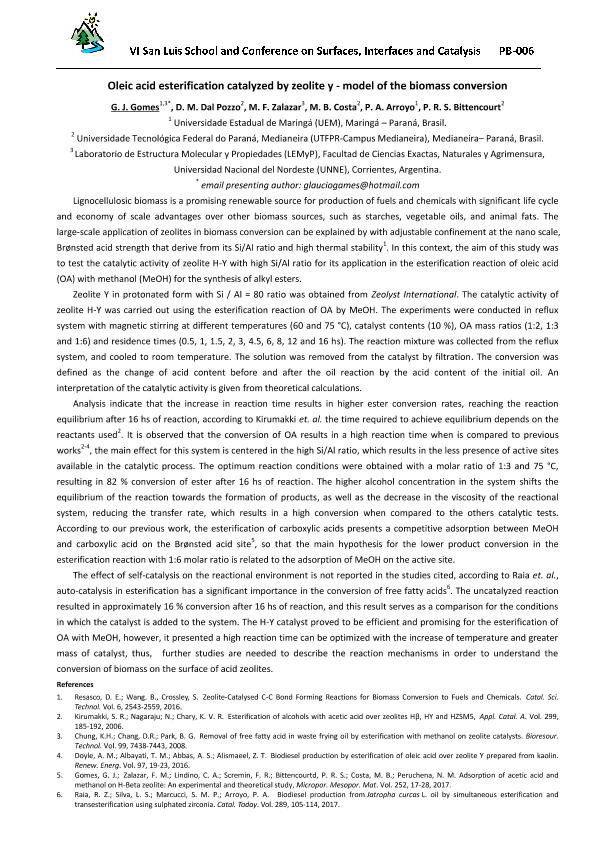Mostrar el registro sencillo del ítem
dc.contributor.author
Gomes, Glaucio José

dc.contributor.author
Dal Pozzo, Daniel M.
dc.contributor.author
Zalazar, Maria Fernanda

dc.contributor.author
Costa, M. B.
dc.contributor.author
Arroyo, Pedro Augusto

dc.contributor.author
Bittencourt, Paulo R. S.
dc.date.available
2022-12-16T14:54:01Z
dc.date.issued
2018
dc.identifier.citation
Oleic acid esterification catalyzed by zeolite y - model of the biomass conversion; VI San Luis School and Conference on Surfaces, Interfaces and Catalysis; Santa Fe; Argentina; 2018; 1-3
dc.identifier.uri
http://hdl.handle.net/11336/181523
dc.description.abstract
Lignocellulosic biomass is a promising renewable source for production of fuels and chemicals with significant life cycle and economy of scale advantages over other biomass sources, such as starches, vegetable oils, and animal fats. The large-scale application of zeolites in biomass conversion can be explained by with adjustable confinement at the nano scale, Brønsted acid strength that derive from its Si/Al ratio and high thermal stability1. In this context, the aim of this study was to test the catalytic activity of zeolite H-Y with high Si/Al ratio for its application in the esterification reaction of oleic acid (OA) with methanol (MeOH) for the synthesis of alkyl esters. Zeolite Y in protonated form with Si / Al = 80 ratio was obtained from Zeolyst International. The catalytic activity of zeolite H-Y was carried out using the esterification reaction of OA by MeOH. The experiments were conducted in reflux system with magnetic stirring at different temperatures (60 and 75 °C), catalyst contents (10 %), OA mass ratios (1:2, 1:3 and 1:6) and residence times (0.5, 1, 1.5, 2, 3, 4.5, 6, 8, 12 and 16 hs). The reaction mixture was collected from the reflux system, and cooled to room temperature. The solution was removed from the catalyst by filtration. The conversion was defined as the change of acid content before and after the oil reaction by the acid content of the initial oil. An interpretation of the catalytic activity is given from theoretical calculations.Analysis indicate that the increase in reaction time results in higher ester conversion rates, reaching the reaction equilibrium after 16 hs of reaction, according to Kirumakki et. al. the time required to achieve equilibrium depends on the reactants used2. It is observed that the conversion of OA results in a high reaction time when is compared to previous works2-4, the main effect for this system is centered in the high Si/Al ratio, which results in the less presence of active sites available in the catalytic process. The optimum reaction conditions were obtained with a molar ratio of 1:3 and 75 °C, resulting in 82 % conversion of ester after 16 hs of reaction. The higher alcohol concentration in the system shifts the equilibrium of the reaction towards the formation of products, as well as the decrease in the viscosity of the reactional system, reducing the transfer rate, which results in a high conversion when compared to the others catalytic tests. According to our previous work, the esterification of carboxylic acids presents a competitive adsorption between methanol and carboxylic acid on the Brønsted acid site5, so that the main hypothesis for the lower product conversion in the esterification reaction with 1:6 molar ratio is related to the adsorption of MeOH on the active site. The effect of self-catalysis on the reactional environment is not reported in the studies cited, according to Raia et. al., auto-catalysis in esterification has a significant importance in the conversion of free fatty acids6. The uncatalyzed reaction resulted in approximately 16 % conversion after 16 hs of reaction, and this result serves as a comparison for the conditions in which the catalyst is added to the system. The H-Y catalyst proved to be efficient and promising for the esterification of OA with MeOH, however, it presented a high reaction time can be optimized with the increase of temperature and greater mass of catalyst, thus, further studies are needed to describe the reaction mechanisms in order to understand the conversion of biomass on the surface of acid zeolites.
dc.format
application/pdf
dc.language.iso
eng
dc.publisher
Universidad Nacional del Litoral
dc.rights
info:eu-repo/semantics/openAccess
dc.rights.uri
https://creativecommons.org/licenses/by-nc-sa/2.5/ar/
dc.subject
HETEROGENEOUS CATALYSIS
dc.subject
ESTERIFICATION
dc.subject
ZEOLITE
dc.subject.classification
Otras Ingeniería Química

dc.subject.classification
Ingeniería Química

dc.subject.classification
INGENIERÍAS Y TECNOLOGÍAS

dc.subject.classification
Físico-Química, Ciencia de los Polímeros, Electroquímica

dc.subject.classification
Ciencias Químicas

dc.subject.classification
CIENCIAS NATURALES Y EXACTAS

dc.title
Oleic acid esterification catalyzed by zeolite y - model of the biomass conversion
dc.type
info:eu-repo/semantics/publishedVersion
dc.type
info:eu-repo/semantics/conferenceObject
dc.type
info:ar-repo/semantics/documento de conferencia
dc.date.updated
2022-12-12T10:39:45Z
dc.journal.pagination
1-3
dc.journal.pais
Argentina

dc.journal.ciudad
Santa Fe
dc.description.fil
Fil: Gomes, Glaucio José. Universidad Nacional del Nordeste. Facultad de Ciencias Exactas y Naturales y Agrimensura. Departamento de Química. Laboratorio de Estructura Molecular y Propiedades; Argentina. Universidade Estadual de Maringá. Departamento de Engenharia Química.; Brasil
dc.description.fil
Fil: Dal Pozzo, Daniel M.. Universidade Federal do Paraná; Brasil
dc.description.fil
Fil: Zalazar, Maria Fernanda. Consejo Nacional de Investigaciones Científicas y Técnicas. Centro Científico Tecnológico Conicet - Nordeste. Instituto de Química Básica y Aplicada del Nordeste Argentino. Universidad Nacional del Nordeste. Facultad de Ciencias Exactas Naturales y Agrimensura. Instituto de Química Básica y Aplicada del Nordeste Argentino; Argentina
dc.description.fil
Fil: Costa, M. B.. Universidade Federal do Paraná; Brasil
dc.description.fil
Fil: Arroyo, Pedro Augusto. Universidade Estadual de Maringá. Departamento de Engenharia Química.; Brasil
dc.description.fil
Fil: Bittencourt, Paulo R. S.. Universidade Federal do Paraná; Brasil
dc.relation.alternativeid
info:eu-repo/semantics/altIdentifier/url/https://servicios.intec.santafe-conicet.gov.ar/eventos/sanluisvi/vi-san-luis-conference/
dc.relation.alternativeid
info:eu-repo/semantics/altIdentifier/url/https://servicios.intec.santafe-conicet.gov.ar/repositorio/index.php/s/Clnhza4uGy3q8EL#pdfviewer
dc.conicet.rol
Autor

dc.conicet.rol
Autor

dc.conicet.rol
Autor

dc.conicet.rol
Autor

dc.conicet.rol
Autor

dc.conicet.rol
Autor

dc.coverage
Internacional
dc.type.subtype
Conferencia
dc.description.nombreEvento
VI San Luis School and Conference on Surfaces, Interfaces and Catalysis
dc.date.evento
2018-06-02
dc.description.ciudadEvento
Santa Fe
dc.description.paisEvento
Argentina

dc.type.publicacion
Book
dc.description.institucionOrganizadora
Instituto de Investigaciones en Catálisis y Petroquímica
dc.description.institucionOrganizadora
Universidad Nacional del Litoral
dc.source.libro
Book of Abstract of the VI San Luis School and Conference on Surfaces, Interfaces and Catalysis
dc.date.eventoHasta
2018-06-08
dc.type
Conferencia
Archivos asociados
